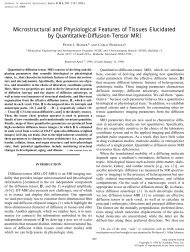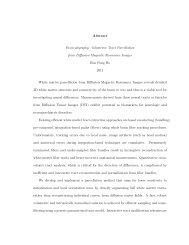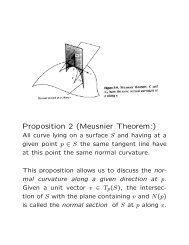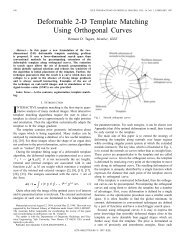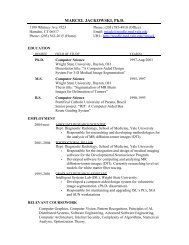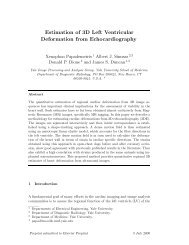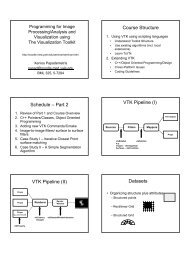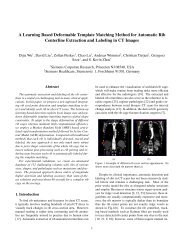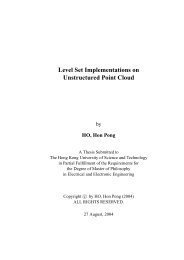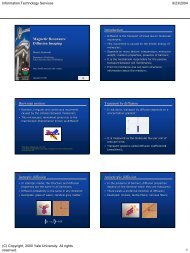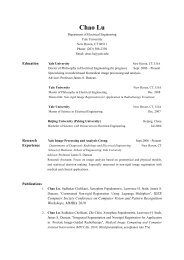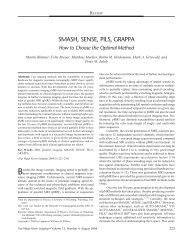Pulsed-field gradient nuclear magnetic resonance as a tool for ...
Pulsed-field gradient nuclear magnetic resonance as a tool for ...
Pulsed-field gradient nuclear magnetic resonance as a tool for ...
Create successful ePaper yourself
Turn your PDF publications into a flip-book with our unique Google optimized e-Paper software.
314<br />
PRICE<br />
brated the <strong>gradient</strong> and decided upon which nucleus<br />
we shall use to probe diffusion, we are left<br />
with three experimental variables to choose from<br />
Ž i.e., , , org. . Incre<strong>as</strong>ing any of these three<br />
parameters will lead to incre<strong>as</strong>ed signal attenuation,<br />
and is thus a means of me<strong>as</strong>uring diffusion;<br />
<strong>for</strong> example, in Fig. 3 we altered . While we are<br />
free to choose which parameter we wish to vary,<br />
the relaxation characteristics of the sample and<br />
technical re<strong>as</strong>ons may limit our choice. Some<br />
simulated ‘‘typical experimental results’’ <strong>for</strong> a<br />
PFG experiment on the waterprotein solution<br />
are plotted in Fig. 5. This simple plot conveys a<br />
wealth of in<strong>for</strong>mation. We have chosen to plot E<br />
2 2 2 on a log scale versus g Ž 3 . , and thus<br />
from Eq. 51 we see that each data set is a<br />
straight line with a slope given by D, where D<br />
is the respective diffusion coefficient of the species<br />
in question. Of course, we could have just plotted<br />
our data against the experimental variable, but by<br />
2 2 2 using g Ž 3. <strong>as</strong> the abscissa, data acquired<br />
using different experimental conditions are<br />
more e<strong>as</strong>ily compared. It can be clearly seen that<br />
<strong>as</strong> the diffusion coefficient decre<strong>as</strong>es Ži.e.,<br />
larger<br />
molecule andor more viscous solution . , the slope<br />
decre<strong>as</strong>es which experimentally is reflected by<br />
less attenuation.<br />
In all of the discussion above, the <strong>gradient</strong><br />
pulses have been taken to be rectangular. This is<br />
more out of technical and mathematical convenience<br />
than necessity. It should be mentioned<br />
that in the PEG experiment the <strong>gradient</strong> pulses<br />
do not have to be rectangular, and in fact to<br />
minimize the generation of eddy currents, it may<br />
be preferable to have nonrectangular pulses. Using<br />
Eq. 49 ,<br />
the effects of arbitrarily shaped <strong>gradient</strong><br />
pulses can be considered Ž 78. and the computations<br />
can be conveniently per<strong>for</strong>med by<br />
simple modification of the Maple worksheet given<br />
in the Appendix. Another commonly used and<br />
totally equivalent means of solving Eq. 41 is to<br />
substitute Eq. 44 ,<br />
but where S is a function of t,<br />
into Eq. 41 directly and solving <strong>for</strong> S to obtain<br />
t<br />
2 2 H<br />
0<br />
lnŽEŽ t.. D F dt. 52 <br />
In evaluating Eq. 52 , the applied <strong>field</strong> <strong>gradient</strong><br />
must be replaced by the effective <strong>field</strong> <strong>gradient</strong>,<br />
g , such that the sign of the <strong>gradient</strong> is changed<br />
eff<br />
Figure 5 A plot of the simulated echo attenuation <strong>for</strong> determining the diffusion coefficient<br />
of water Ž . and protein Ž . . The simulations were per<strong>for</strong>med using Eq. 51 with<br />
1H 8 1 1 1 2.6571 10 rad T s , g 0.2 T m , 100 ms, and ranging from 0 to<br />
10 ms. The diffusion coefficient of water and the protein were taken to be 2.33 109 and<br />
1 10 10 m 2 s 1 , respectively. As the diffusion coefficient incre<strong>as</strong>es, the slope of the line<br />
incre<strong>as</strong>es. If lnŽ E. is plotted on a linear scale versus the same abscissa the slope is given by<br />
D Žsee Eq. 51 . .



